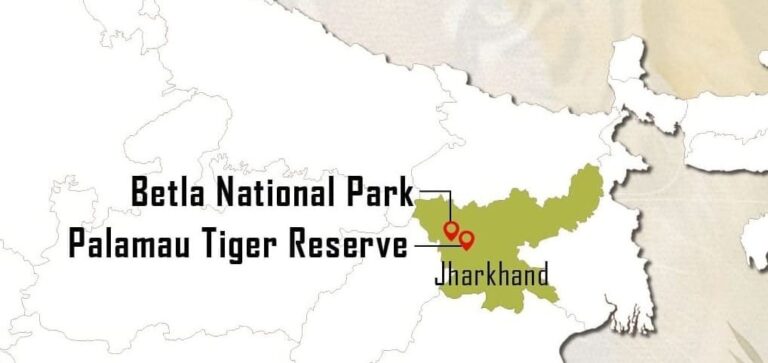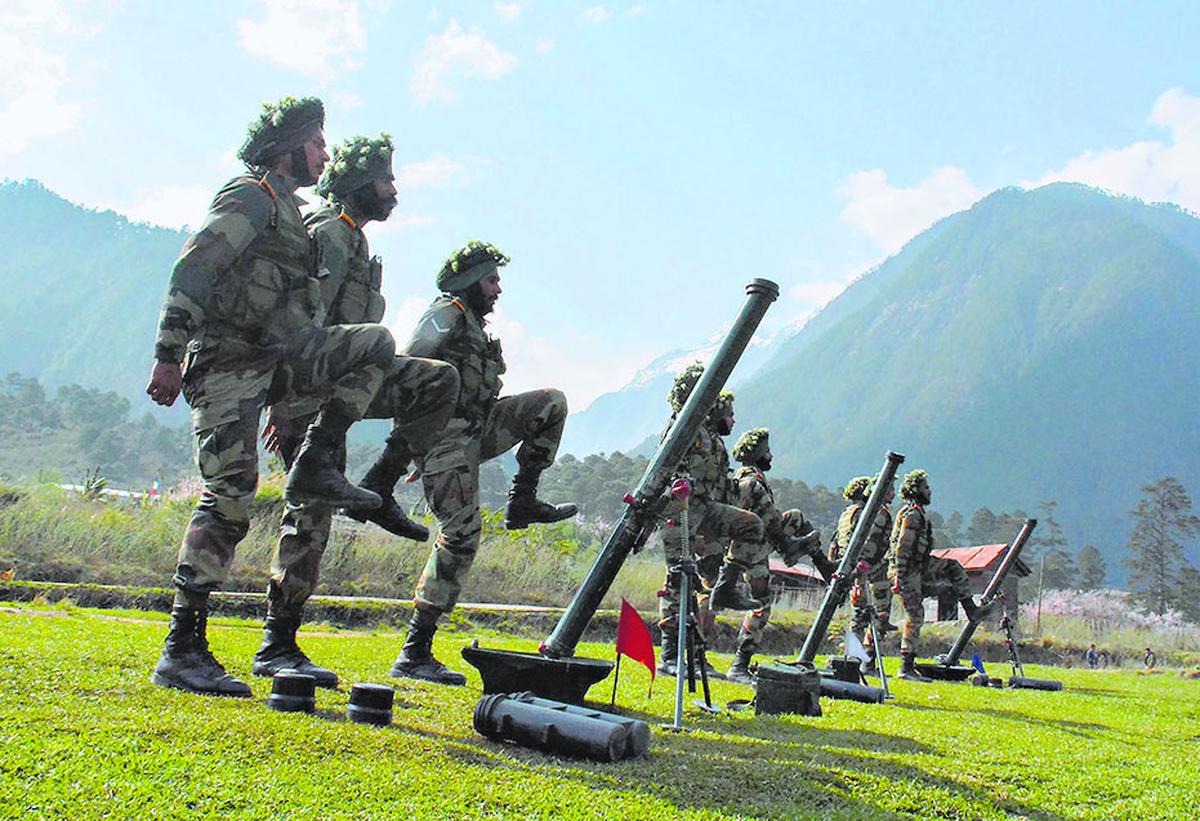AI-enabled Centre at Betla National Park

- 27 Sep 2025
In News:
Betla National Park, located in Latehar district, Jharkhand, will soon host India’s first AI-enabled nature experience centre. Part of the Palamu Tiger Reserve (PTR), the park is known for its rich biodiversity, including tigers, elephants, and diverse flora and fauna. PTR is one of the first nine tiger reserves established under Project Tiger (1973), covering a total area of 1,129.93 sq. km, and was notified as a National Park in 1986.
About the AI-Enabled Centre
The centre, developed by Palamu Tiger Reserve authorities under Deputy Director Prajesh Kant Jena, aims to provide visitors with an immersive, high-tech wildlife experience. Unlike conventional nature interpretation centres, it will use cutting-edge technologies to recreate the dynamics of the jungle ecosystem, including:
- AI assistants for guided learning.
- 3D holographic projections to display lifelike animal behaviour.
- Augmented Reality (AR) and immersive sound effects to simulate waterfalls, bird calls, predator-prey interactions, and herd movements.
- Ecosystem simulation, portraying animal movement, food-sharing activities, and other natural behaviours in a realistic manner.
Purpose and Significance
The centre, themed “Threads of Nature,” is designed to convey the interconnection between humans and nature. Key objectives include:
- Enhancing eco-tourism by offering a realistic jungle experience, including sightings of tiger hunts, elephant herds, and lions.
- Promoting conservation awareness through interactive learning and observation tools.
- Supporting researchers and nature enthusiasts with virtual wildlife monitoring capabilities.
Unique Features
While nature interpretation centres have existed in Betla since the 1970s, this facility represents the first high-tech effort in India to integrate AI, AR/VR, holograms, and immersive sound for wildlife education. Visitors will not just see static models or photographs but will experience the sights, sounds, and atmosphere of a living jungle, providing a deeper understanding of ecosystem dynamics.
By merging technology with conservation education, the Betla AI-enabled centre is poised to become a pioneering hub for tourism, research, and ecological awareness in Jharkhand and across India.
Combined Operational Review and Evaluation (CORE) Programme

- 27 Sep 2025
In News:
- The Headquarters Integrated Defence Staff (HQ IDS) is organising the Combined Operational Review and Evaluation (CORE) Programme at the United Service Institution of India, New Delhi.
- The initiative serves as a unique platform for civil-military engagement on national and regional security, bringing together senior officers from the Indian Armed Forces alongside officials from the Ministries of Defence, External Affairs, and Home Affairs.
Objectives and Significance
The CORE Programme aims to:
- Strengthen civil-military synergy in addressing multidimensional security threats.
- Enhance strategic awareness among senior officers and develop their capacity for balanced, pragmatic decision-making.
- Foster leadership development and inter-agency coordination in complex national and international security scenarios.
The programme underscores HQ IDS’s commitment to jointness within the Armed Forces and professional development, preparing participants to navigate dynamic security challenges effectively.
Key Themes and Focus Areas
The CORE Programme covers a spectrum of contemporary security issues, including:
- Regional and global security challenges
- Technological transformation of warfare
- Strategic communication
- Inter-agency collaboration and joint problem-solving
The programme employs a combination of lectures, interactive discussions, and sessions with subject-matter experts and professionals from diverse fields. This approach broadens participants’ outlook, encourages collaborative solutions, and strengthens the intellectual foundations of senior leadership.
Participants
The five-day programme brings together senior civil and military officers, facilitating a holistic understanding of national security from multiple perspectives. By promoting dialogue across the defence and civilian sectors, CORE enhances preparedness to address complex, multidimensional threats at both national and international levels.
Phytosaur fossil
- 27 Sep 2025
In News:
Recent paleontological excavations in Megha village, Fatehgarh subdivision, Jaisalmer district, Rajasthan, have uncovered fossilised remains that may belong to a Phytosaur, a large, extinct semi-aquatic reptile. This discovery has generated significant excitement in the scientific community and reinforces Jaisalmer’s reputation as a paleontological hotspot.
About Phytosaurs
Phytosaurs are extinct reptiles of the order Phytosauria, resembling modern crocodiles, which thrived during the Late Triassic to Early Jurassic period. They displayed morphological diversity, including:
- Long-snouted forms (primarily fish-eating)
- Short-snouted forms (adapted for terrestrial prey)
- High-snouted forms (generalist feeders)
Phytosaur fossils have been reported in India, Europe, North America, Brazil, Morocco, Thailand, and Madagascar, highlighting their wide distribution and evolutionary significance.
Significance of the Find
The Megha village fossil adds to Jaisalmer’s growing list of paleontological finds, which includes dinosaur footprints, shark fossils, and marine remains. Experts suggest that the site may contain additional hidden fossils, which could provide crucial insights into:
- The evolution of prehistoric reptiles
- Convergent evolution with modern crocodilians
- Jurassic-era biodiversity and climate in India
If confirmed as a Phytosaur, the fossil will enhance our understanding of prehistoric fauna in the Indian subcontinent and strengthen the region’s global paleontological significance.
Striped Dolphin
- 27 Sep 2025
In News:
- In a rare observation, a pod of striped dolphins (Stenella coeruleoalba) was recently sighted off the Visakhapatnam coast in Andhra Pradesh.
- The sighting, captured on video by a local fisherman from Muthyalammapalem, has drawn attention to the rich but under-documented marine biodiversity of India’s eastern coastline.
- The species was identified by the East Coast Conservation Team (ECCT) with assistance from the Marine Mammal Research and Conservation Network of India — marking one of the few verified records of striped dolphins in Andhra waters.
About Striped Dolphins (Stenella coeruleoalba)
|
Aspect |
Details |
|
Family |
Delphinidae (Oceanic dolphins) |
|
IUCN Status |
Least Concern |
|
Distribution |
Found in tropical and temperate waters of all major oceans — including the Mediterranean Sea, Japan, South Africa, Western Australia, New Zealand, and occasionally, Indian waters. |
|
Habitat |
Prefer deep offshore waters and upwelling zones where nutrient-rich cold water supports abundant marine life. Often found near continental shelf edges. |
|
Physical Features |
Length: ~2.2–2.6 m; streamlined body; long beak (rostrum); tall, curved dorsal fin. Notable dark stripes run from the beak through the eye and down the sides, giving the species its name. |
|
Behaviour |
Found in tight pods of 25–100 individuals. Known for acrobatics such as breaching, leaping, and the characteristic “roto-tailing” — a spinning motion of the tail while airborne. |
|
Lifespan |
Up to 58 years. |
|
Diet |
Primarily small fish, squid, and crustaceans. |
Ecological and Conservation Significance
The recent sighting highlights the ecological richness of the Bay of Bengal, especially the Visakhapatnam coast, which supports diverse marine fauna but remains scientifically under-surveyed.
Such sightings are crucial for:
- Enhancing knowledge about the migratory patterns and population structure of marine mammals in Indian waters.
- Assessing ecosystem health, since dolphins are indicator species reflecting the condition of marine food chains.
- Formulating regional conservation policies for marine biodiversity and sustainable fisheries.
The ECCT’s collaboration with fishermen exemplifies a community-based conservation model, where local knowledge complements formal scientific documentation — essential for protecting fragile marine ecosystems.
Recent Discoveries Indicating Biodiversity Potential
During recent coastal surveys, researchers even rediscovered a sea slug species in Visakhapatnam that had not been recorded in nearly 180 years, further proving the hidden biodiversity of India’s east coast and the urgent need for systematic monitoring.
Protecting India’s Satellites

- 27 Sep 2025
In News:
Following a near-miss incident in 2024 between an Indian satellite and a foreign spacecraft, India has intensified efforts to protect its growing constellation of satellites. Given the critical role of satellites in national security, communication, and economic infrastructure, safeguarding them has become a strategic necessity.
Why Protecting Satellites is Crucial
India’s satellites are vital for a range of civilian and defence functions — from weather forecasting and navigation (NavIC) to internet services, surveillance, and global communications. They underpin sectors such as aviation, shipping, agriculture, and disaster management, while also enabling secure military operations.
However, these assets face increasing threats:
- Space debris and collisions — The expanding number of satellites and fragments in orbit raises the risk of accidental impacts.
- Hostile manoeuvres — Adversarial satellites may shadow or interfere with India’s space assets.
- Cyber threats — Ground stations and networks remain susceptible to hacking, jamming, and spoofing.
- Solar storms and space weather — Events like coronal mass ejections can damage satellite electronics and disrupt signals.
With the high costs of launching and maintaining satellites, ensuring their safety protects India’s technological investment and strategic autonomy.
India’s Ongoing and Planned Initiatives
- IS4OM (ISRO System for Safe and Sustainable Space Operations and Management): Located in Bengaluru, this centre continuously tracks India’s satellites and provides collision-avoidance alerts, enabling timely orbital manoeuvres to prevent accidents.
- Project NETRA (Network for Space Object Tracking and Analysis): An ambitious space surveillance system comprising radars and telescopes to build indigenous Space Situational Awareness (SSA) capabilities. It will allow India to monitor space debris and detect suspicious satellite movements in real-time.
- Aditya-L1 Mission: India’s first solar observatory mission monitors solar storms and radiation patterns, providing early warnings about solar events that could threaten satellite operations.
- ?27,000-crore Surveillance Satellite Programme (2026–2032): India has approved the launch of 52 surveillance satellites to strengthen real-time observation, border monitoring, and space domain awareness — forming the backbone of future space defence capabilities.
- CERT-In Satellite Cybersecurity Guidelines (2025): New cybersecurity protocols mandate strong encryption, network segmentation, and data protection norms to prevent satellite hacking or signal spoofing.
- IN-SPACe Licensing and Regulation: Private players are now integrated into India’s space ecosystem, but under strict safety and cybersecurity standards to ensure the security of the commercial space sector.
- Debris-Free Space Mission (By 2030): Announced at the Inter-Agency Space Debris Coordination Committee (IADC) in 2024, India has pledged to adopt sustainable space practices and avoid debris creation during launches and operations.
Emerging Plan: “Bodyguard Satellites”
India is reportedly considering deploying bodyguard satellites — specialised spacecraft that will act as orbital escorts for high-value satellites.
Functions and Features:
- Proximity monitoring: Detect when debris or foreign satellites come dangerously close.
- Threat identification: Track hostile proximity operations or suspicious manoeuvres.
- Protective action: Reposition themselves or guide the protected satellite to avoid collisions or interference.
- Strategic deterrence: Aligns India with global trends where major space powers (like the US, Russia, and China) are deploying similar defensive technologies.
Challenges:
- Technological: Requires advanced sensors, AI-driven autonomy, and ultra-precise orbital manoeuvring systems.
- Financial: High development and launch costs demand sustained investment.
- Cybersecurity: Satellite-ground communication remains a potential vulnerability.
- Geopolitical: May trigger suspicion or an arms race in outer space.
- Sustainability: Increased orbital activity must not worsen the space debris problem.
Way Forward
- Strengthen indigenous SSA: Invest in LiDAR, radar, and optical satellite networks to monitor all orbital zones.
- Enhance anti-jamming and encryption systems: Build resilient, autonomous communication systems immune to interference.
- Public–Private Collaboration: Encourage startups and private firms to co-develop low-cost, high-tech satellite protection tools.
- Global cooperation: Engage actively with international bodies like COPUOS and IADC to promote transparency and responsible behaviour in space.
- Defensive-first approach: Focus on non-weaponised, sustainable defence mechanisms to maintain peace and prevent escalation in outer space.
